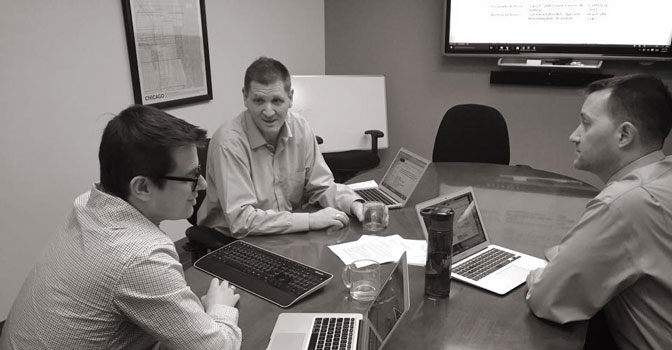
The big brown bins are back. Our building (230 W. Monroe) has propped them outside the elevators, asking for food contributions for the Chicago Greater Food Depository. ’Tis the season and we have lots to be thankful for. We also have good reason to give back, and we thought you might, too. We’ve rounded up a few local organizations/charities with brief descriptions of their respective missions and dates for upcoming volunteer opportunities. Below is a list of places that the members of our firm either know well and/or have worked with in the past. We hope you’ll get to know them as well this holiday season.
Chicago Greater Food Depository
There’s a long history here. The depository has been around since 1979 and has grown substantially since then. A network of 650 pantries, soup kitchens, shelters, mobile programs, children’s programs, and other ventures, has long been a stalwart non-profit of Cook County. Last year, the depository distributed 68 million pounds of food equaling 155,000 meals a day for those less fortunate, and the depository shows no signs of slowing down. This year’s numbers could be bigger than the last with your help.
A relatively time-friendly volunteer option for those with little time to spare is on the horizon. Down in the Loop, volunteers for the Union Station Food Drive (Nov. 18 + 19) will be handing out brown paper bags to commuters during the evening of Nov. 18. Commuters are asked to fill the bags with shelf-stable food and return them the following morning, which volunteers then collect. Last year’s drive brought in more than 14,000 pounds of food in less than 24 hours.
Chicago Thanksgiving Basket Brigade 
During last year’s Thanksgiving Day celebration, the Basket Brigade distributed 36,000 pounds of food to more than 1,500 families—over 1,000 volunteers participated. Inspired by the childhood experience of notable pitchman Tony Robbins, this charity focuses on providing struggling families with small but meaningful contributions to uplift their spirits during the holiday season.
The Brigade’s Assembly Day takes place the Sunday morning before Thanksgiving (the designated meeting place is still TBD). Volunteers help unload trucks, organize food, and distribute baskets around town before meeting a designated celebration location to eat, drink and, revel in some seasonal fun. If you’re not able volunteer, you have an opportunity to sponsor a family with a food basket ($30) that feeds a family of five.
Founded in 1989, the Inspiration Corporation helps redirect the lives of homeless folks by providing education programs, mock interview for job seekers, tutoring, housing services and workforce development, among other things. The non-profit has several short-term and long-term volunteer opportunities for people with diverse backgrounds, or you can simply take your enthusiasm and hit the ground running. A short training session is required prior to joining, but the sessions are relatively short and happen frequently around town. Inspiration typically hosts hundreds of people each year for a special Thanksgiving celebration, and this year will likely be no different. If Thanksgiving doesn’t work out, there are plenty of year-round volunteer opportunities for you to learn about.
This national non-profit has a familiar ring to it. For 25 years, Meals on Wheels has been collecting and delivering food to the homeless and people with disabilities. The organization’s crop of 500-or-so active volunteers has doubled since 2007. With their help, MOW continues to invest in the popular Holiday Meals Program, Home-Delivered Meals for Individuals with Disabilities, and the Home Modification Program, all of which serve to fill financial gaps in government subsidies to its two city partners. The local chapter of MOW supports these two partners through fundraising efforts like the option below.
On Tuesday, December 1, Meals on Wheels hosts Giving Tuesday, a volunteer event at the Thompson Hotel. You can help pack shelf-stable meal boxes for MOWC’s homebound seniors and individuals with disabilities. You can also partake in light refreshments and cocktails for just $20, all of which is donated to the programs of Meals on Wheels. You’re free to stop by anytime between 2–9pm.
This ubiquitous holiday charity was established in 1995 as an official activity of the U.S. Marine Corps and an official mission of the Marine Corps Reserve. It began as a way to supplement the toy collections of local units that had fewer Marines because of military cutbacks in the ’80s and ’90s, among other things, and has since gone on to provide toys to those less fortunate. Over 494 million toys have been distributed to more than 230 million people around the country.
You can drop off new unwrapped toys at the Toys for Tots Chicago drop off location at 3034 W. Foster Ave between 8am–8pm. If you’d like to volunteer, you can fill out a form available on the Toys for Tot website.











 Around 2004, my mom was diagnosed with breast cancer. I remember the day she told the family. She’d just come home from the hospital and the look on her face was grim. She didn’t hold back, telling my younger brother and me that the outlook was not good. Though that particular memory stays with me, my most vivid memories during that time aren’t so grim.
Around 2004, my mom was diagnosed with breast cancer. I remember the day she told the family. She’d just come home from the hospital and the look on her face was grim. She didn’t hold back, telling my younger brother and me that the outlook was not good. Though that particular memory stays with me, my most vivid memories during that time aren’t so grim.